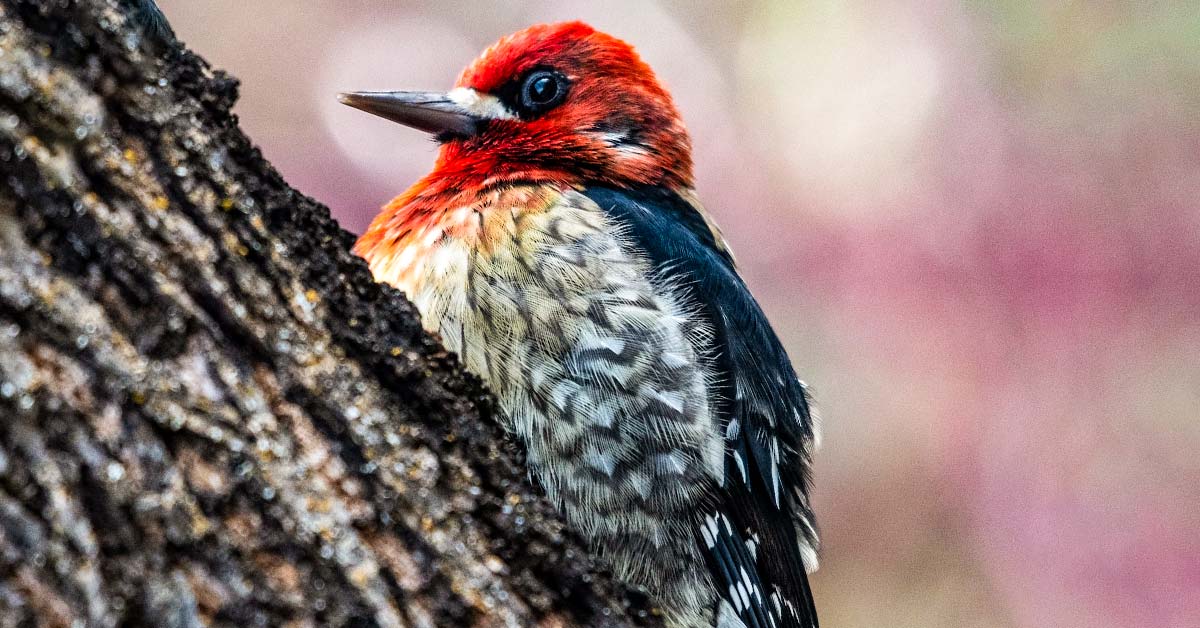America’s Last Frontier is home to over 470 species of birds, but if you’re like me and you’re obsessed with the sound, look and personality of woodpeckers, check out these 7 striking woodpeckers in Alaska.
These adorable little birds, mostly in black and white with pops of color, occupy the forested regions of Alaska.
7 Woodpeckers in Alaska
Only seven woodpecker species call Alaska home and they are the northern flicker, the yellow-bellied sapsucker, the red-breasted sapsucker (shown above), and the downy, three-toed, hairy, and black-backed woodpeckers.
Read more about them below.
1. Northern Flicker (Colaptes auratus)
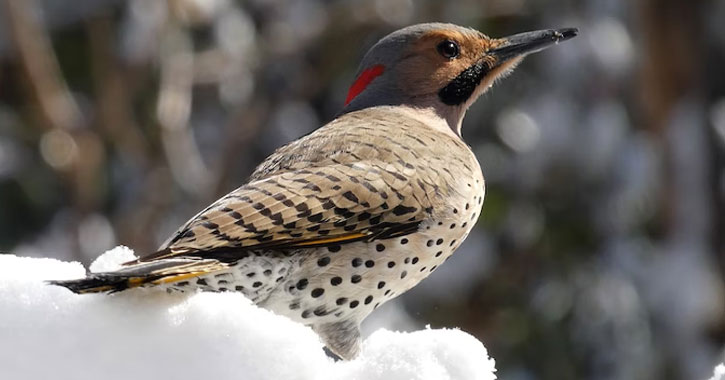
Northern flickers are easy to identify because they’re not typical woodpeckers. They’re known as woodpeckers that don’t peck wood.
Instead of pecking through trees to find their food, they feed on the ground instead. However, the motion (pecking through the dirt in jackhammer fashion) is the same as other woodpeckers.
Where to find Northern Flickers in Alaska
Two kinds of Northern Flickers call Alaska home. You’ll find the red-shafted Northern flicker around the Southeast part of the state, while the yellow-shafted ones live throughout Alaska.
Appearance: How to spot Northern Flickers
Northern flickers have a white rump patch. Males may look like they have a red or black mustache extending back of their bills.
These birds are about 5 ounces in weight and can grow as big as 12 inches with 16 to 20-inch wingspan.
Unlike other woodpeckers, the Northern flickers have curved beaks (bills), which is also the reason why they don’t like foraging on wood.
Northern Flicker Sound
Northern flickers are known for their quick bursts of drumming and ringing calls during mating season.
They also have a loud call that sounds like “Wake-up, wake-up, wake-up!”
2. Yellow-bellied sapsucker (Sphyrapicus varius)
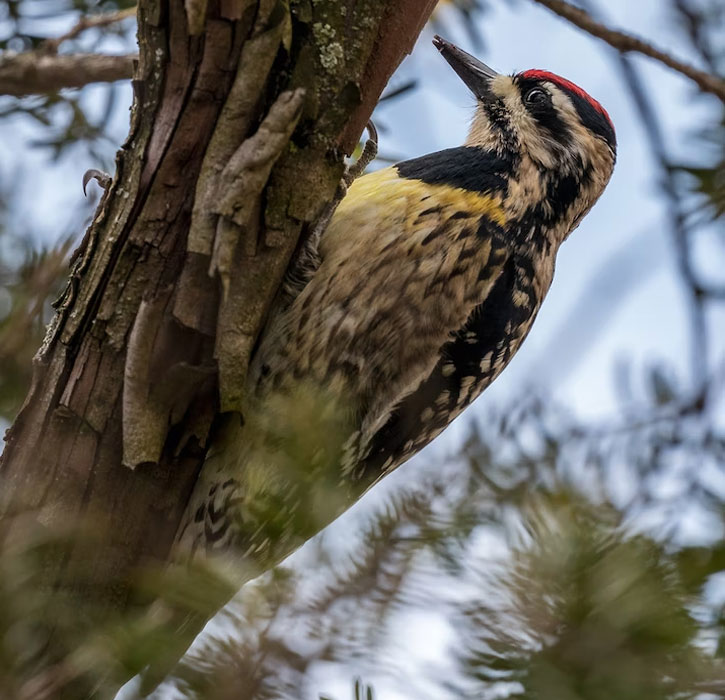
The Yellow-bellied Sapsucker also lives in Alaska, but they’re not as common as the Northern flicker.
You’d actually be lucky to spot one since they prefer to stay in the forests.
Where to find Yellow-bellied sapsuckers in Alaska
Yellow-bellied sapsuckers have been seen only a few times in Alaska in the past 20 years, but they’re known to breed in temperate and boreal forests.
Appearance: How to spot Yellow-bellied sapsuckers
Yellow-bellied sapsuckers are characterized by their white bellies with a tinged of yellow (females have faint yellow, while males have brighter-yellow bellies). These birds also have black and white barred wings and back.
Both males and females have red foreheads, but you can tell if it’s a female yellow-bellied sapsucker if the woodpecker has a white throat (males have bright red throats).
Yellow-bellied sapsucker Sound
Yellow-bellied sapsuckers have a scratchy repetitive call when breeding.
Like other sapsuckers, the drumming noises you might hear from this bird are due to them drilling rows of sap wells into tree barks.
3. Red-breasted sapsucker (Sphyrapicus ruber)
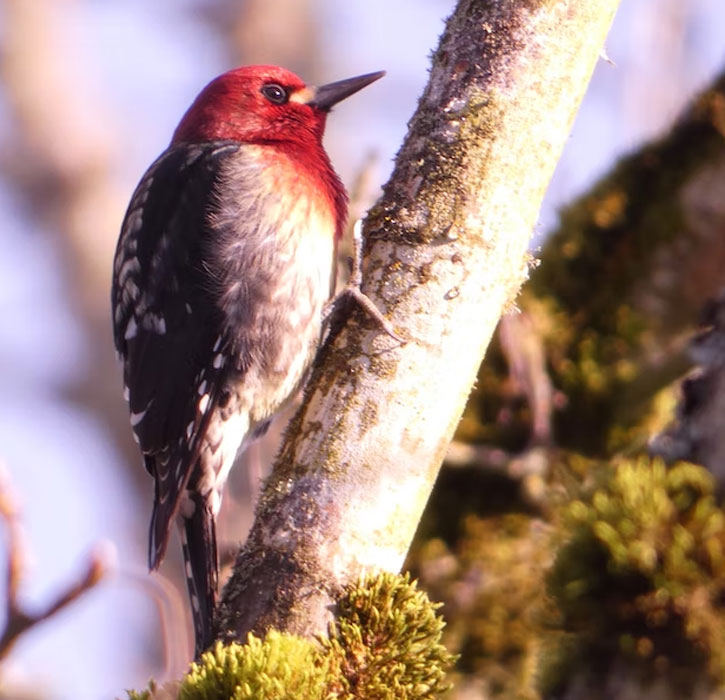
Two sapsucker species are known to occur in Alaska – the yellow-bellied (above) and red-breasted sapsuckers. The two used to be thought of as the same type of bird but are now classified separately.
Where to find Red-breasted sapsuckers in Alaska
Red-breasted sapsuckers occur only in Southeast Alaska but they’re also very rare even there.
Appearance: How to spot Red-breasted sapsuckers
Red-breasted Sapsuckers have red-colored heads, necks, and chests.
These mid-sized red woodpeckers are definitely striking with the prominent red tinge and black and white feathers on their tails and wings.
Red-breasted sapsucker Sound
The red-breasted sapsucker has a call that sounds like raspy weeps.
They also chirp, drum, and give a wide range of songs.
4. Downy woodpecker (Dryobates pubescens)
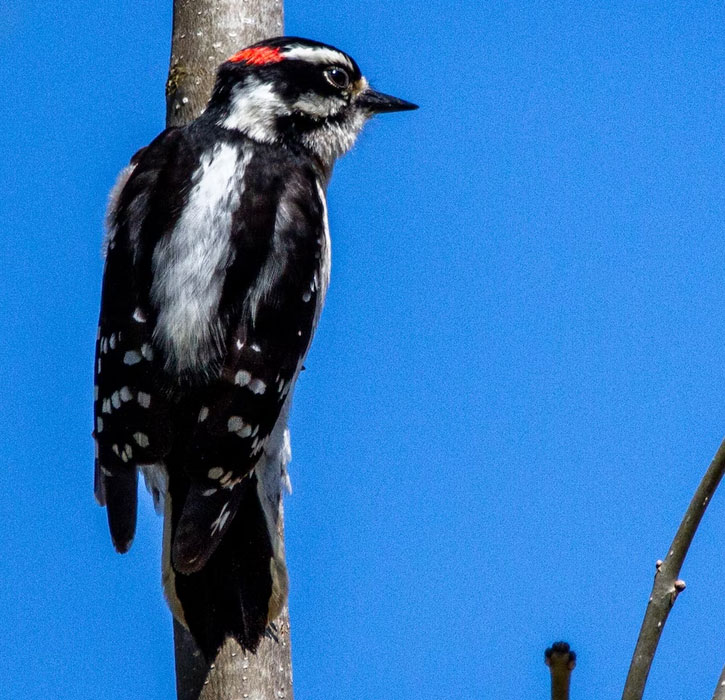
The Downy Woodpecker is one of the smallest woodpecker species not only in Alaska but also in the country measuring just around 6 inches long and weight under an ounce.
Where to find Downy woodpeckers in Alaska
Downy woodpeckers may be small, but they’re one of the easiest to find because they’re very common birds in Alaska. Plus, they visit backyards and spend time in various habitats as long as there are wooded areas with a nearby water source.
While these birds visit feeders, Downy woodpeckers are often found in open woodlands, parks, and orchards.
Appearance: How to spot Downy woodpeckers
Downy woodpeckers have black and white plumage, mostly black on their backs with a white patch. Spotting males is easy – you can see a red patch on the back of a male downy woodpecker’s head.
Downy woodpecker Sound
Downy Woodpeckers make high-pitched pik sounds, whiny calls, and slightly-slower drumming than other woodpeckers.
5. American Three-toed woodpecker (Picoides dorsalis)

The American three-toed woodpeckers are named for their (you guessed it) three toes!
While they look similar to the black-backed woodpecker, you’ll differentiate this one because they tend to lean back (they don’t have a choice due to their three toes).
Where to find Three-toed woodpeckers in Alaska
The three-toed woodpecker is the most abundant and widespread woodpecker in Alaska, mostly found in mature spruce forests.
Appearance: How to spot Three-toed woodpeckers
American Three-toed woodpeckers are primarily black with white chests, white barring on their sides and backs, plus a bright yellow crown and black and white striped head.
Three-toed woodpecker Sound
These woodpeckers are some of the noisiest around. Once they begin pecking at their choice of bark, you can definitely hear the aggressiveness miles away.
6. Hairy woodpecker (Dryobates villosus)
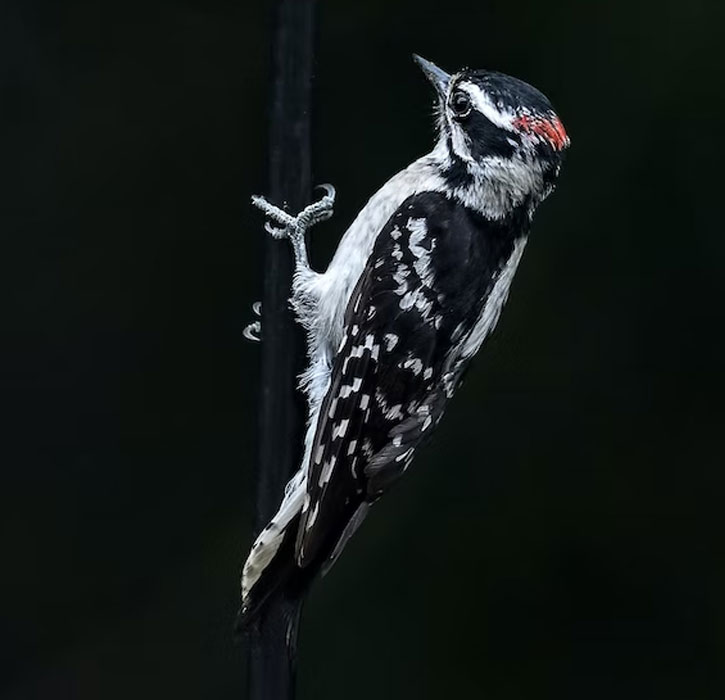
The hairy woodpeckers and downy woodpeckers are often mistaken for the downy woodpeckers because both have:
- black and white striped heads
- all-white chest
- black wings with patterned white dots
However, there are definitely some slight differences.
Where to find Hairy woodpeckers in Alaska
Hairy woodpeckers are year-round residents of Southeastern Alaska.
If you visit the Tongass National Forest, these birds can be observed in all forested areas.
Appearance: How to spot Hairy woodpeckers
If the downy and hairy woodpeckers are side-by-side, you can pinpoint which one is “hairy” mainly because of the thick their “hair” appears.
Of course, the chances of seeing both at the same time are slim.
Instead, check the outer tail feathers – hair woodpeckers only have white feathers.
The black bill (beak) of the hairy woodpecker is also long and pointed with white coloring.
Hairy woodpecker Sound
Even the call of hairy woodpeckers (the short and sharp notes) are similar to the downy woodpecker.
They also have whinny or rattling calls.
7. Black-backed woodpecker (Picoides arcticus)
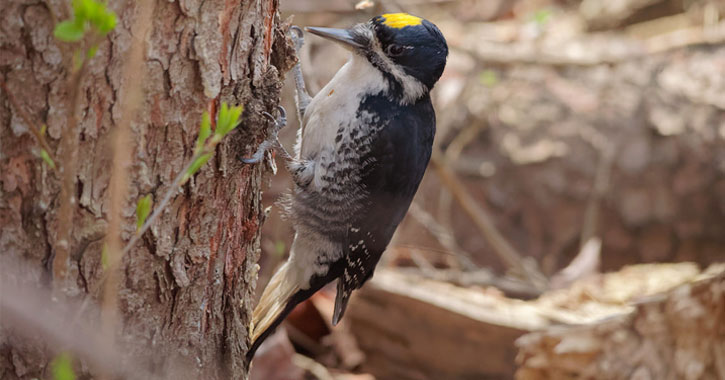
The black-backed woodpecker is pretty striking – almost crowlike because of its solid-black back.
Where to find Black-backed woodpeckers in Alaska
The black-backed woodpecker is a resident of Southeastern Alaska. They can be found in the forested parts of the state, but they are uncommon and difficult to observe.
Most of these woodpeckers live in forests that have had fires in the last decade.
Appearance: How to spot Black-backed woodpeckers
This woodpecker has shiny, black hairy plumage, which helps them camouflage in the forest.
The most distinct thing about black-backed woodpeckers is the yellow cap (in males). The females have an all-black cap though.
Black-backed woodpecker Sound
The most common call of black-backed woodpeckers is a sharp high-pitched “pik” with whinny parts that end in a growl-sounding snarl.
Other Woodpeckers in Alaska
How many species of woodpeckers are in Alaska? The 7 types of woodpeckers above are found regularly in the state, but other species could also “visit” even if they’re not native to this state.
Make sure to take photos when you get a glimpse of woodpeckers other than those on this list because they come pretty rare.
Whether they’re native to Alaska or not, all of these woodpeckers play an important part in Alaska’s forest ecosystems. They eat thousands of beetle larvae. (Yup, a single woodpecker could gobble up around 13,000 beetle larvae each year!).
As they hunt for beetle larvae, they also remove loose bark that smaller insects and birds couldn’t have destroyed themselves when foraging.
If you want to see more woodpeckers, head over to the Natural State and check out the 10 native woodpeckers in Arkansas.
